Last Updated on August 9, 2017
Featured snippet is somewhat a mysterious search feature. This tutorial explains what featured snippet is and provides step-by-step guide for optimizing your website pages to rank at position 0.
Ranking at the first position on Google search results is the ultimate goal of SEO for most site owners. However, achieving this dream can be a grueling task if you are in a competitive market. To rank at position 1 in Google search engine result pages in such a market will take investment and efforts that many site owners are not able to put in.
I am not trying to undermine your ability to do SEO, what I am stating is there is an opportunity to even outrank that coveted position 1 in Google. With a featured snippet you get to rank at position 0, and this ranking has less to do with link metrics, but more with the actual content of the page. What it means for you is, even when you are behind in terms of backlinks, featured snippets can help you steal the traffic from the top position competitions in the Google SERPs.
It is not hard to imagine that what impact featured snippets will have on a page’s visibility and traffic when it appears at position 0 even when the URL of the very same page is ranked below position 5 or even on page 2 in Google SERPs.
What is a featured snippet?
According to the Stone Temple Consulting at present 30% of Google search results contain featured snippets. These snippets appear above the normal search results, that is why they are called position 0 rankings. The prominence of rich answer continuing to grow, it’s time you also include optimization of your pages to be included in rich snippets. Here is a graph showing the growth of rich answers in Google’s search results: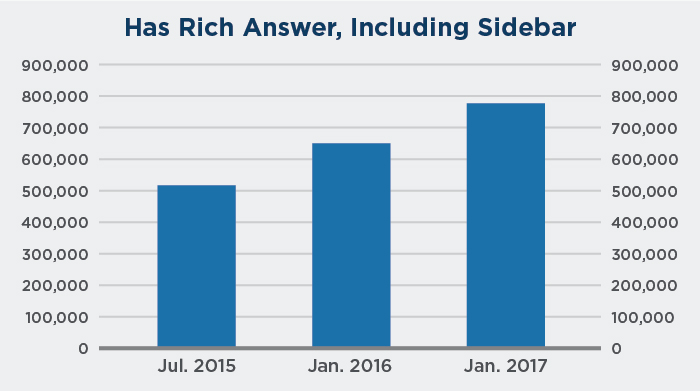
Image Credit – https://www.stonetemple.com/
A featured snippet is similar to direct answers, but it also contains the URL and the title of the page along with a rich snippet from the page’s content that attempts to answer the searcher’s query. Here is an example of a direct answer for a search in Google SERP:
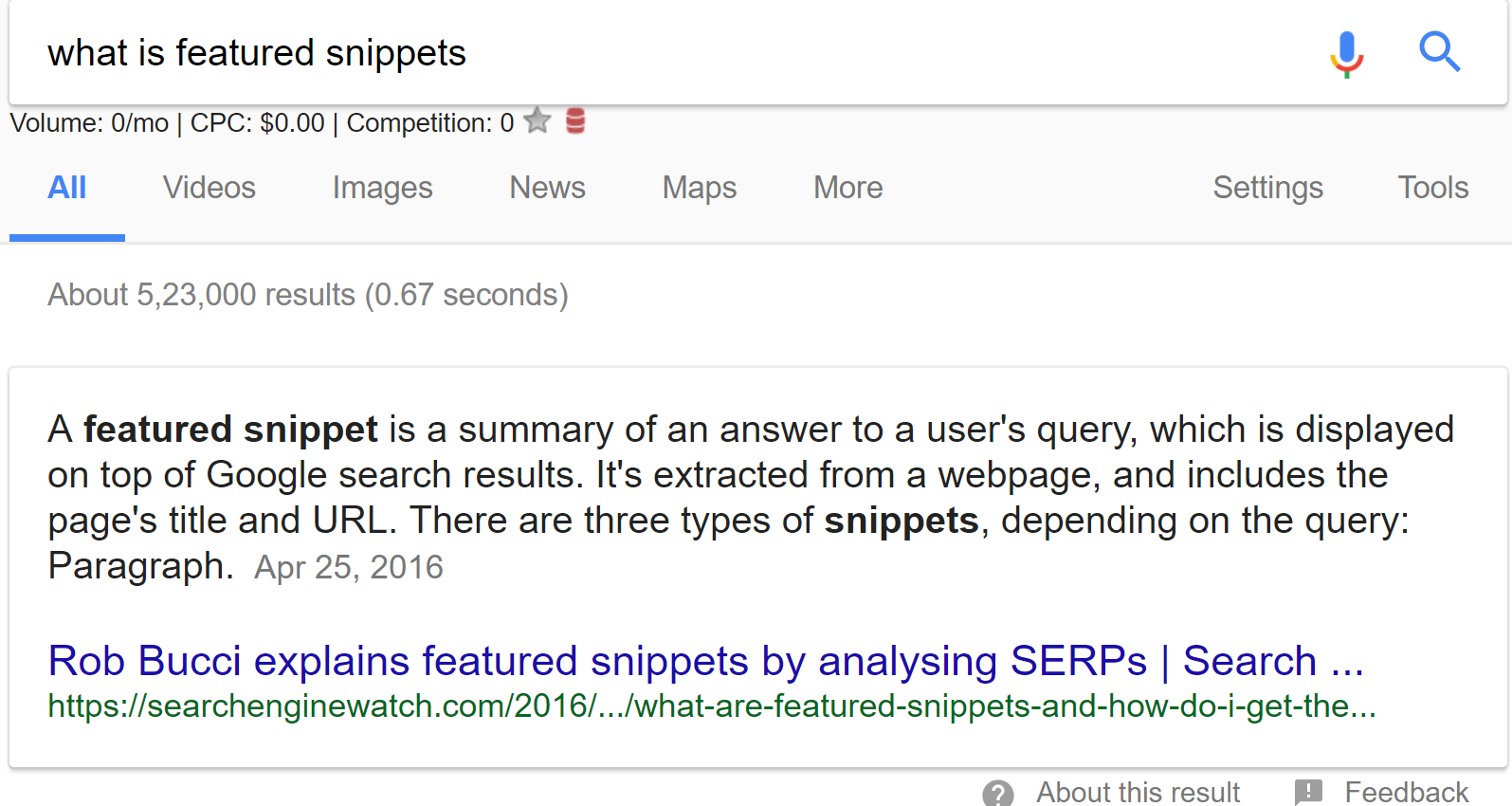
When the user tried to look for the definition of Search Engine Optimization, Google provided him with a direct answer sourced from its own knowledge base. This has no significance for your website as there is no page title or url shared in the direct answer. Now if the same searcher looks for information on ‘how to do SEO’, Google provides this result at position 0: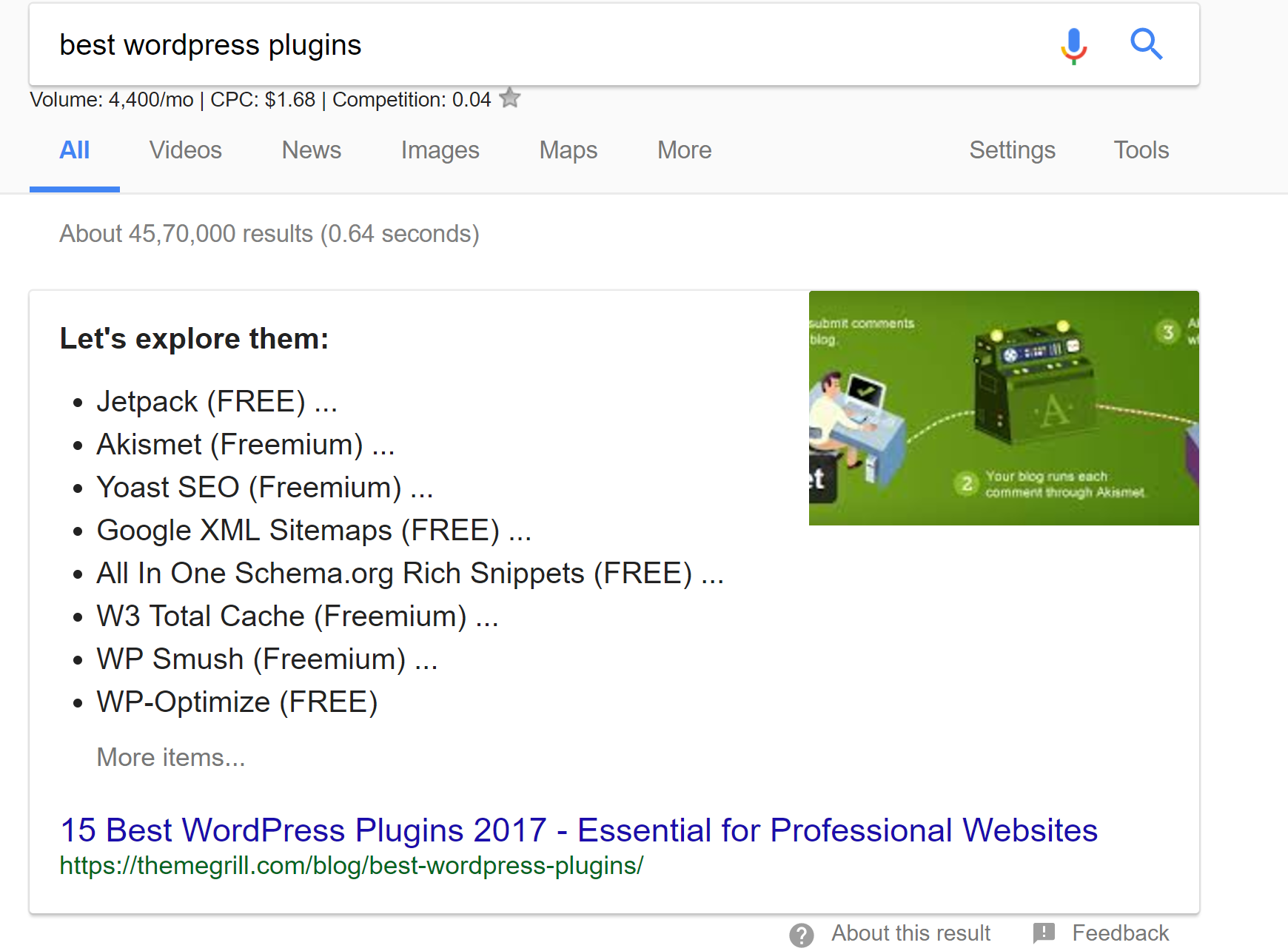
As you can see the featured snippet has the page title as well as the URL, it is very likely to increase your page’s Google visibility as well as get more traffic. The content that appears in these snippets is programmatically detected by Google depending on the user’s question. Almost every website owner with feature snippets in the SERPs, has reported a significant increase in the CTR (click-through rate) for the website pages that have featured snippets.
Why do you have to care about the featured snippet?
As we mentioned before ranking in the top spot in Google SERP in a competitive market is a challenge, appearing in a featured snippet is a lot easier. But it is not the only reason to optimize the web pages for position 0. Another reason is that you easily can steal traffic from the top ranked competitors if your web page appears at position 0.
In an analysis of over two million featured snippets, Ahrefs found that there is a significant drop in organic traffic of first result when a featured snippet is present in Google SERP. Here’s a chart from Ahrefs: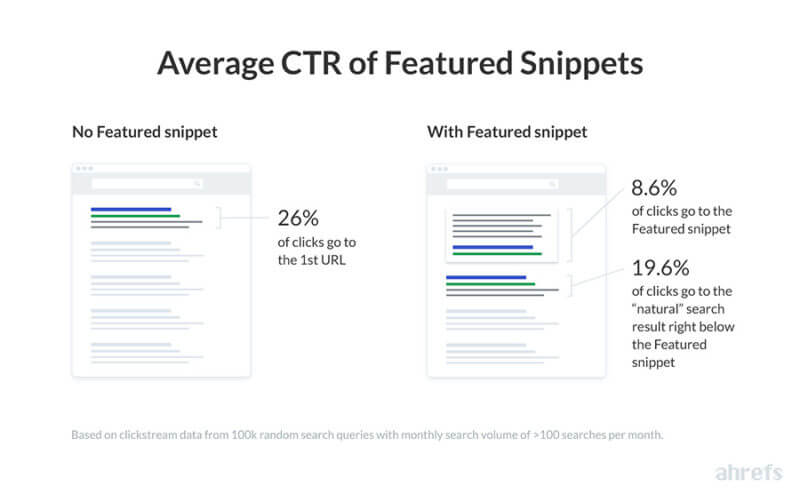
As you can see that the first result gets 26% CTR when there is no featured snippet. However, the CTR drops to 19.6% for a first result when there is a featured snippet. Surprisingly, the position 0 page stole 8.6% CTR from the position 1 result.
Do you need more reason to focus on optimizing your website pages for featured snippets? Now lets move on to the steps to snap the coveted position 0 spot in the SERPs.
How to rank for ‘position 0’?
- Have a clear view of the opportunity for your site
If you followed this tutorial this far, you understand that with featured snippets Google is trying to provide easy answers to searchers. This is the reason why not all websites can expect to be included at position 0. If you are a local business or an ecommerce store, you are better off investing your time and budget in ranking in Google map results. You can get a better idea why is that from this Stat Search Analytics study. The study details that searches related to local, info/help, factual, shopping or images and videos rarely returned a featured snippet.
You are in luck if your website deals in a market where frequently asked questions are common or you are in an industry where jargons and technical terms are used and people need to search explanation of those terms or your web pages have data presented in tabular format. All of these characteristics make your site or web page an ideal candidate to be included in a featured snippet. The aforementioned study after reviewing 92,0000 search queries concluded that following search types are most likely to generate a featured snippet:
- Health
- Financial
- Time
- Mathematical
- DIY Processes
- Transitional
- Requirements
- Status
This study might tempt you into trying to just focus your entire optimization strategy on question-focused keywords, but it is not that easy. Surprisingly, it is not necessary that if you rank at position 0 today, you will be at the same position a week later. You see the appearance in featured snippet is really dynamic. If your approach only involves making use of question oriented keywords that you may find yourself in a featured snippet, but it won’t be long lived.
First, you need to find if your site already appears in featured snippets for any keyword or not. If it does head towards the Google Search Console and analyze the CTR data for the page that is positioned at rank 0. Comparing the CTR data for the time you are in a featured snipped with the time you were not will enable you to estimate the potential boost in CTR you are can expect.
On the flip side, if your website is not in the featured snippets, you need to analyze your competitor’s position 0 pages to derive a list of keywords you will be focusing on. There are several tools available to spy on your competitors feature snippet generating keywords, but SEMrush outguns every other tool.
SEMrush for featured snippet analysis
Head towards SEMrush dashboard (you will prompted to signup, there is no fee). Once you are logged into the dashboard, follow the following steps: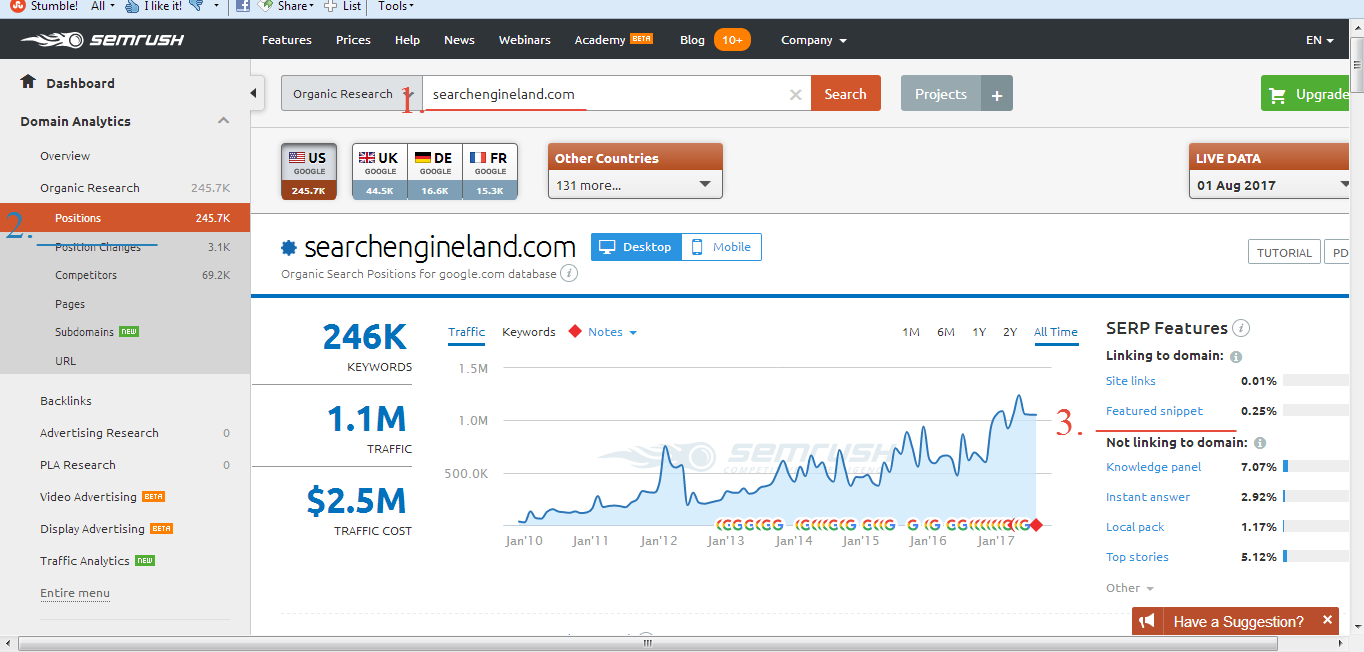
#1. Enter the competitor’s domain in the organic research search bar (marked in image as position 1)
#2. Head over to “Positions” in the window that opens (marked in image as position 2)
#3. Once you click the positions link detailed organic research data will show on the screen, head over to the right side “SERP Features” and click on “Featured snippet” link (marked in image as position 3)
You are all set to reveal the secret keywords that rank your competition at the coveted position 0.
- Find the right keywords to rank in featured snippets
The step above provides you with only a baseline to understand what kinds of keywords can get you in the featured snippet, you need to research deeper to find keywords that are suitable for your web pages.
Finding keywords to rank in featured snippet is nothing different from your traditional keyword research. You focus on finding:
- High search volume keywords to get snippets more often
- Longer queries that comprise of six or more words often generate featured snippets, optimize pages accordingly
- As mentioned before position 0 content is to answer queries, pay attention to explicit questions that can be incorporated into your web page content. Questions like how, what, where, who and why tend to return featured snippets often.
Don’t forget ‘People also ask’ Section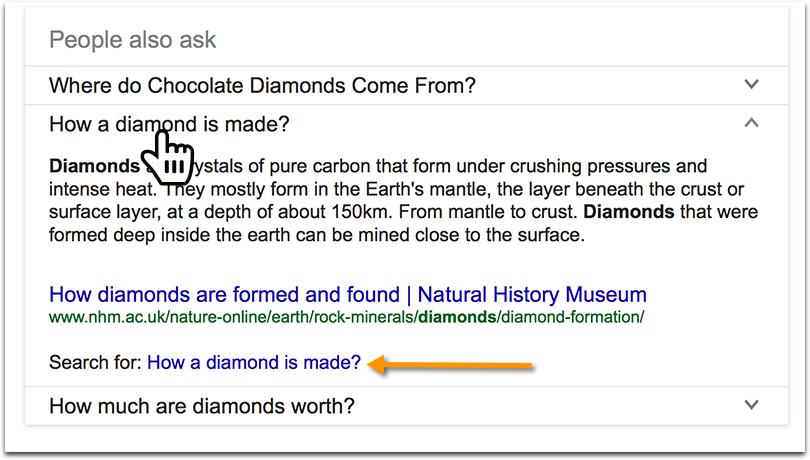
Image above shows the ‘People also ask’ section shown in Google SERPs. You can see that for the particular query Google did not return any featured snippet, but when you take a question from the ‘People also ask’ section, (we searched for “is usps and fedex the same”) and search for it, a featured snippet appears, as shown in the image below.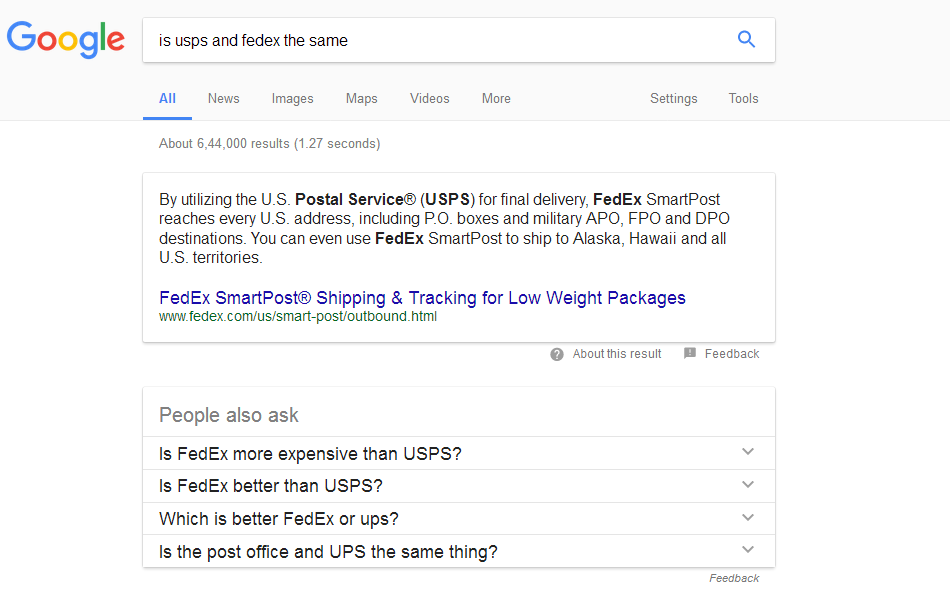
- Increasing the potential for featured snippet selection
You can increase the potential of an already existing or a new web page to appear in featured snippet by follow three step simple multi-pronged approach.
- Directly answer the question
- Clean HTML code
- Positive user engagement
While optimizations web pages to appear at position 0 you need provide clear answers to the questions being queried. For this you can repeat the question prominently in the content. A clear and direct answer to the question must follow next. After, the answer provide additional information with data, images and tables.
Next, you have to make sure your page has clean code and tagging that Google can easily understand. Best practices that we recommend are:
- Make the query or the question appear as heading. Recommended practice is to close the query with H1 or H2 HTML tags.
- The answer to the query must be summarized in a single paragraph of 40-50 words and enclosed within the HTML paragraph tag <p>. Place the paragraph directly after the question heading.
- Lists and tables boost the chances of a content appearing in featured snippets. Make sure if the content of the page is an answer with delineating steps, include HTML tags like <li>, <ol> and <ul> for lists.
- An important step in optimizing content for featured snippets is when you are using tables in the content. Instead of using CSS to lay out tabled use HTML <table> tag.
Furthermore, if possible try to format the content of a page in a question-and-answer layout to make it easier for Google to pick a short answer from the content for featured snippet.
As far as existing web pages are concerned, you need to first look at the analytics data of a page to understand whether it makes a suitable candidate to appear in featured snippet or not. Google only cares about delivering the best search results and if a page has poor average session duration and page views and high bounce rate, it certainly is not going to rank at position 0.
Quality content will always matter
Presumably, we provide you will all the information you need to optimize your site pages for position 0. Still, we want to explicitly state content structuring and tagging is useful in ranking for position 0, but most of your focus must be on answering the related question in the very best way possible. Great answers and content is not only favored by Google but is also rewarded by greate
